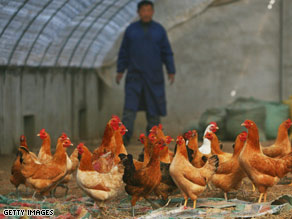Re: China: Woman, 19, Confirmed H5N1 Death - Contacts Monitored
Human to Human H5N1 Transmission In Beijing?
Recombinomics Commentary 00:39
January 7, 2009
The Beijing Municipal Health Bureau said 116 people were in close contact with the victim.
One healthcare professional in contact with Huang contracted bird flu, but recovered, the bureau said.
The above comments describe transmission of H5N1 from the fatally infected patient to a health care worker, which is a major red flag signaling an increase in transmission efficiency. Although other media sources acknowledged the fever and recovery in the health care work, none stated that the fever was due to an H5N1 infection.
Transmission to a health care worker is rare. Most H5N1 H2H transmission involves an index case and family members who are not trained in universal precautions, and have minimal protection. Therefore, independent confirmation of this transmission would be useful.
H5N1 cases in Beijing are also rare. The last confirmed case from Beijing was the first confirmed case in mainland China in 2003. That case was due to clade 7 H5N1, which is more common in the Beijing area, which is why it is likely that the latest human case was also caused by clade 7. The most recent confirmed H5N1 in poultry in mainland China were two outbreaks in Jiangsu, and both were clade 7.
Clade 7 is of concern because it is distinct from other H5N1 that is associated with human infections. Clade 1 is in southeast Asia and caused human case in Vietnam, Thailand, and Cambodia between 2004-2005. Although it is still circulating in poultry in southeast Asia, there have been few of any recent clade 1 human cases. Clade 2.1 is circulating in Indonesia and account for all public sequences, although Indonesia has not released a human H5N1 sequence for the past two years. Clade 2.2 is carried by wild birds west of China, and have cause human infections in Turkey, Iraq, Azerbaijan, Egypt, Djibouti, Nigeria, Pakistan, and Bangladesh. Clade 2.3 has cause human cases in China, and more recently in Vietnam and Thailand.
However, prior to the latest case, the only reported clade 7 infection was in Beijing.
If the source of the H5N1 for the latest case was linked to the ducks purchased at the market, then it is possible that they were asymptomatically infected, which would also increase concerns.
Release of sequences from this case, as well as the Jiangsu outbreaks, would be useful as would clarification of the cause of the fever in the health care worker.
Originally posted by niman
View Post
Recombinomics Commentary 00:39
January 7, 2009
The Beijing Municipal Health Bureau said 116 people were in close contact with the victim.
One healthcare professional in contact with Huang contracted bird flu, but recovered, the bureau said.
The above comments describe transmission of H5N1 from the fatally infected patient to a health care worker, which is a major red flag signaling an increase in transmission efficiency. Although other media sources acknowledged the fever and recovery in the health care work, none stated that the fever was due to an H5N1 infection.
Transmission to a health care worker is rare. Most H5N1 H2H transmission involves an index case and family members who are not trained in universal precautions, and have minimal protection. Therefore, independent confirmation of this transmission would be useful.
H5N1 cases in Beijing are also rare. The last confirmed case from Beijing was the first confirmed case in mainland China in 2003. That case was due to clade 7 H5N1, which is more common in the Beijing area, which is why it is likely that the latest human case was also caused by clade 7. The most recent confirmed H5N1 in poultry in mainland China were two outbreaks in Jiangsu, and both were clade 7.
Clade 7 is of concern because it is distinct from other H5N1 that is associated with human infections. Clade 1 is in southeast Asia and caused human case in Vietnam, Thailand, and Cambodia between 2004-2005. Although it is still circulating in poultry in southeast Asia, there have been few of any recent clade 1 human cases. Clade 2.1 is circulating in Indonesia and account for all public sequences, although Indonesia has not released a human H5N1 sequence for the past two years. Clade 2.2 is carried by wild birds west of China, and have cause human infections in Turkey, Iraq, Azerbaijan, Egypt, Djibouti, Nigeria, Pakistan, and Bangladesh. Clade 2.3 has cause human cases in China, and more recently in Vietnam and Thailand.
However, prior to the latest case, the only reported clade 7 infection was in Beijing.
If the source of the H5N1 for the latest case was linked to the ducks purchased at the market, then it is possible that they were asymptomatically infected, which would also increase concerns.
Release of sequences from this case, as well as the Jiangsu outbreaks, would be useful as would clarification of the cause of the fever in the health care worker.
 <!--===========/IMAGE===========--> <!--===========CAPTION==========-->Nantong of Jiangsu province, China, last month, where the H5N1 virus was discovered.<!--===========/CAPTION=========-->
<!--===========/IMAGE===========--> <!--===========CAPTION==========-->Nantong of Jiangsu province, China, last month, where the H5N1 virus was discovered.<!--===========/CAPTION=========-->




Comment